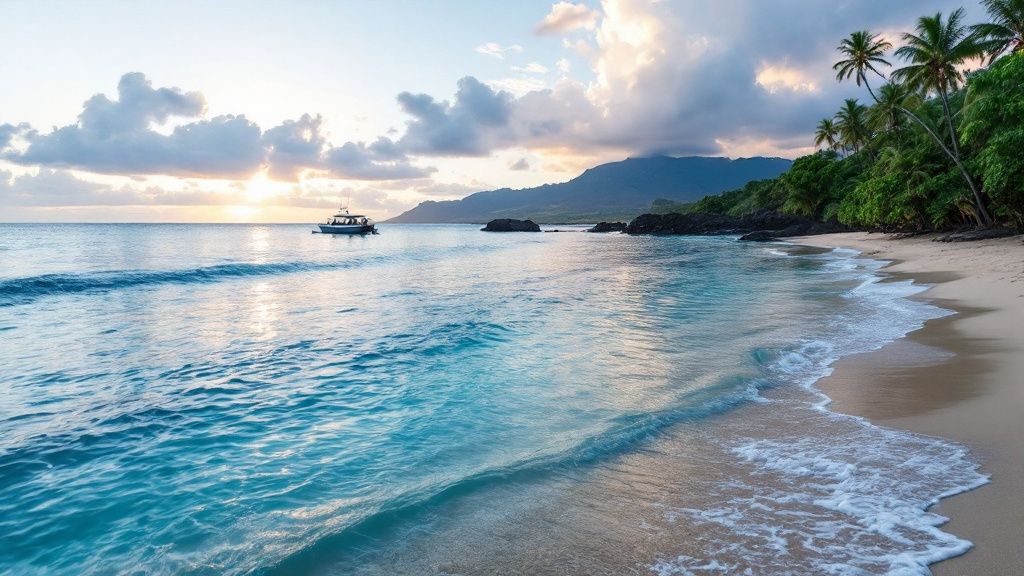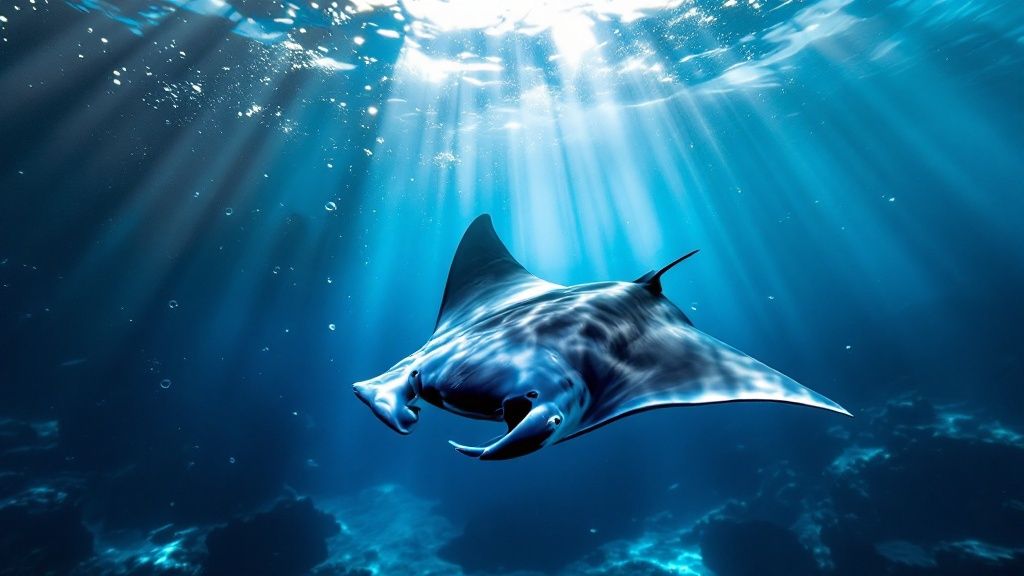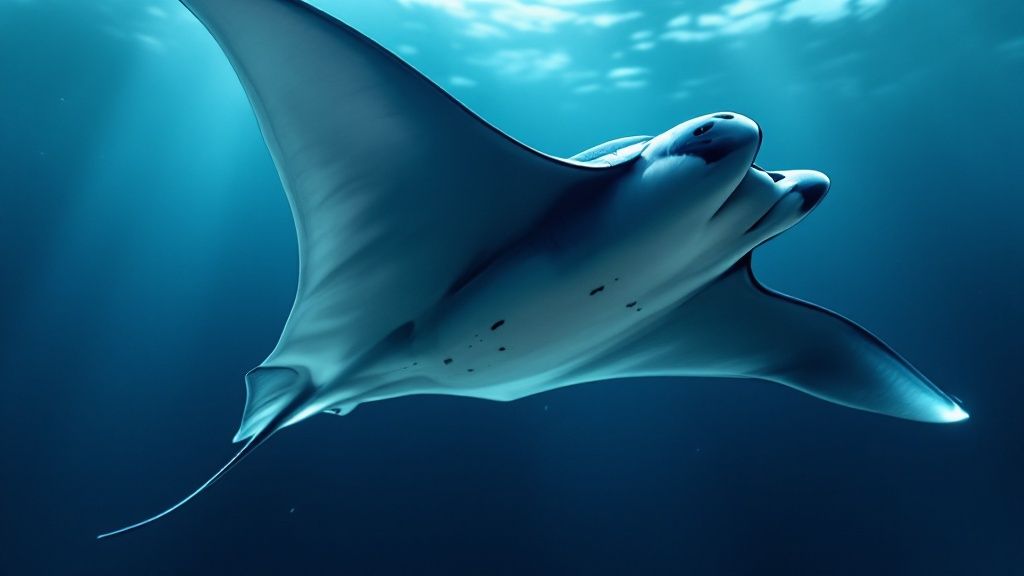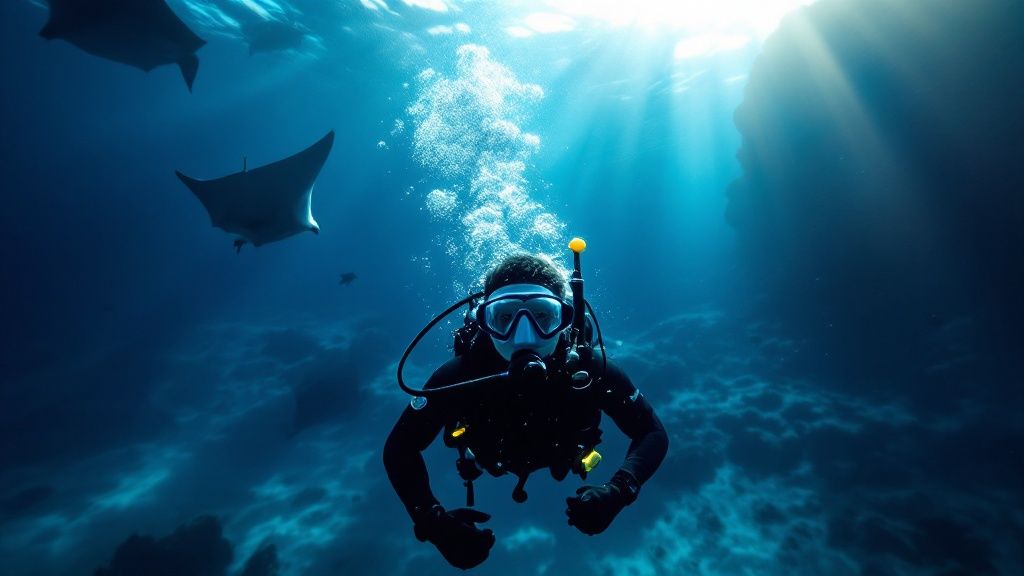Manta Ray Dive Kona: Epic Hawaiian Adventure
- Byron
- Apr 13
- 10 min read
The Magic Behind Kona's World-Famous Manta Ray Encounters

Kona, Hawaii, is more than a tropical getaway; it's a manta ray haven. This isn't by chance. The magic of Kona's manta ray encounters stems from a special combination of natural elements. The island's volcanic underwater terrain creates deep slopes and canyons. These formations channel nutrient-rich currents, fueling consistent plankton growth – the manta ray's main food source. This creates a reliable buffet, attracting these gentle giants night after night.
This dependable food supply makes Kona a unique manta ray hot spot. You can find more information on our ocean life in our blog post sitemap. While other locations may offer the occasional glimpse of a manta ray, Kona provides practically guaranteed encounters. This reliability attracts both curious visitors and researchers studying these graceful creatures. Manta ray dives in Kona are world-renowned for their consistency.
The Kona coast, especially around areas like Manta Village and Manta Heaven, offers an exceptional opportunity to witness these magnificent animals. In 2013, Manta Village reported a 96% success rate for manta ray sightings, with an average of four mantas per tour. Learn more about these statistics. This impressive success rate is thanks to the underwater topography and nutrient-rich environment. Volcanic slopes and ocean currents create concentrated plankton pockets, drawing mantas regularly.
The Role of Underwater Topography
The underwater topography further enhances the viewing experience. The sloping volcanic seabed is ideal for the "campfire" effect employed by tour operators. Divers and snorkelers gather around specialized lights that attract plankton, which in turn brings in the mantas. This results in a stunning display of graceful barrel rolls and chain-feeding formations just below the surface.
Why Kona is Special
What truly distinguishes Kona is the accessibility of these encounters. Through options like our two-tank manta ray dive and snorkel trip, both experienced divers and newcomers can witness this marine wonder. Kona's unique blend of nutrient-rich waters, volcanic formations, and responsible tour operators creates an unforgettable experience. It’s an experience that continues to attract people from around the world.
Prime Locations for Unforgettable Manta Ray Dives

The Kona coast offers several incredible spots for manta ray dives. Two stand out: Manta Village in Keauhou Bay and Manta Heaven, also known as Garden Eel Cove. These locations are famous for consistent and memorable manta ray encounters. Yet, each site offers a unique experience.
Manta Village: The Original Manta Ray Dive Site
Manta Village is considered the original manta ray night dive location. Located south of Kona, its shallow, sandy bottom creates the perfect setting for the mesmerizing "manta ballet." Divers kneel in a semi-circle, their dive lights angled upwards to create a "campfire" effect. This attracts plankton, the manta rays' main food source, bringing them close to the surface in dramatic feeding displays.
This predictable manta ray behavior makes Manta Village perfect for divers of all levels, from beginners to seasoned pros. Interested in another underwater adventure? Consider a two-tank manta ray dive and snorkel trip.
Manta Heaven: A Cove of Graceful Giants
North of Kona lies Manta Heaven, offering a different perspective. This site is known for larger groups of manta rays. While sightings might be slightly less frequent than at Manta Village, divers are often treated to the stunning spectacle of multiple mantas performing their graceful feeding acrobatics. The deeper water and sometimes stronger currents make Manta Heaven better suited for more experienced divers.
Exploring Beyond the Famous Two
Beyond these two popular sites, other less-known locations offer unique manta ray diving opportunities off Kona. These hidden gems, favored by local divers, provide a more intimate, less crowded experience. Sightings might be less predictable, but the chance for a private encounter with these gentle giants is a compelling draw. These secluded locations often feature unique underwater landscapes and diverse marine life, enhancing the dive experience.
To help you choose the best dive site for your skill level, here's a comparison of the key features of the main manta ray dive locations in Kona:
Manta Ray Dive Sites in Kona: Comparison of the main manta ray dive locations along the Kona coast with key features for divers
Location | Success Rate | Best Time | Depth | Experience Level | Special Features |
|---|---|---|---|---|---|
Manta Village | High | Night | Shallow | Beginner to Experienced | "Manta ballet" feeding displays |
Manta Heaven (Garden Eel Cove) | Medium-High | Night | Deeper | Experienced | Larger manta ray aggregations |
Other Kona Coast Sites | Varies | Varies | Varies | Varies | Secluded, unique topography |
This table summarizes the key differences between the popular sites and the less-frequented dive locations. While Manta Village provides a reliable and shallow experience, Manta Heaven offers the potential for larger groups of mantas in deeper water. The "other" Kona Coast sites present an element of adventure and the possibility of a more private encounter.
The Big Island's thriving manta ray population is due to its nutrient-rich waters and volcanic formations. Manta rays are attracted to Kona's currents, which support abundant plankton blooms. This reliable food source explains the frequent manta ray sightings, making Kona a prime destination for manta ray enthusiasts. You can also find more information on our sitemap. Understanding the unique features of each dive location helps divers choose the perfect experience for their skill level and ensures a truly unforgettable manta ray encounter.
The Manta Ray Dive Experience: From Briefing to Encounter

A manta ray dive in Kona isn't just another dive; it's a carefully orchestrated interaction between humans and these magnificent creatures. It all starts with a pre-dive briefing. Experienced guides, like those at Kona Honu Divers, explain the dive procedures, manta ray behavior, and the importance of respecting these gentle giants.
This briefing is vital for both diver safety and minimizing impact on the manta rays. The journey to the dive site itself is part of the adventure. As you cruise across the water, guides often share fascinating details about the local ecosystem. They also highlight the specific reasons why Kona is such a special place for manta rays. You might be interested in learning more about these amazing animals: Here's a collection of blog posts about manta ray experiences.
The Underwater Setup: Creating the Manta Ray "Campfire"
Arriving at the dive site is where the magic truly begins. Divers enter the water and descend to the sandy bottom, usually in relatively shallow depths. They position themselves around a unique lighting system designed to attract plankton, the manta rays' main food source. These lights create what's called a "campfire" effect, drawing the plankton closer to the surface and, in turn, the manta rays.
The lights not only illuminate the water for the divers but also provide a spectacular show as the plankton glows, creating a surreal backdrop for the approaching mantas. Divers kneel or sit in a semi-circle on the ocean floor, giving the manta rays ample space to move freely within the illuminated area. This minimizes disruption to their natural feeding behavior.
The Manta Ray Encounter: A Dance of Grace and Wonder
Drawn by the illuminated plankton, the manta rays begin their breathtaking underwater ballet. They glide effortlessly through the water, performing impressive barrel rolls and complex chain-feeding formations. These formations highlight their intelligence and intricate social dynamics. Observing these majestic creatures up close is a truly unforgettable experience.
The manta rays' looping motion while feeding is particularly captivating. With mouths wide open, they circle the lighted area, filtering the plankton-rich water. Divers often describe this as a "manta ballet" because the rays appear to dance through the illuminated water. Their close proximity provides a unique opportunity to see their distinct markings and graceful movements.
To help visitors choose the right experience, here's a comparison table:
Manta Ray Dive vs. Snorkel Experience
Feature | Diving Experience | Snorkeling Experience | Best For |
|---|---|---|---|
Depth | Deeper, closer to the ocean floor | Surface level | Those comfortable in deeper water vs. those who prefer to stay near the surface |
Interaction | Closer proximity to manta rays | Observation from above | More intimate encounter vs. a broader perspective |
Equipment | Requires scuba gear and certification | Requires basic snorkel gear | Experienced divers vs. all skill levels |
Physical Exertion | More physically demanding | Less demanding | Active individuals vs. those seeking a relaxed experience |
This table summarizes the key differences between diving and snorkeling with manta rays. Choosing the right experience depends on your comfort level in the water, your desired level of interaction with the mantas, and your physical capabilities.
Addressing Diver Concerns and Conservation Efforts
Many divers are curious about their proximity to the mantas. Responsible operators stress passive observation. Divers are instructed not to touch the mantas because this can harm their delicate mucous layer, which shields them from bacteria and parasites. This focus on conservation is crucial for preserving the manta ray population for future generations.
Another common question revolves around photography in these low-light conditions. While capturing these amazing moments can be tricky, even simple cameras can create stunning images with the right settings and some helpful guidance. Experienced guides will often share practical tips on how to best photograph these magnificent creatures without interrupting their natural behavior. They also frequently explain how operators achieve a balance between creating memorable experiences and adhering to stringent conservation practices. This underscores the vital role of responsible tourism.
Perfect Timing: When to Plan Your Manta Ray Adventure

Manta rays grace Kona's waters throughout the year. However, understanding seasonal variations can greatly enhance your manta ray dive Kona experience. These nuances affect manta ray behavior and your chances of a truly memorable encounter. Factors like water temperature, plankton blooms, and overall ocean conditions all contribute to the experience.
Seasonal Variations and Manta Ray Activity
Water temperature changes impact plankton density, directly influencing manta ray feeding habits. Plankton, the manta rays' main food source, is also affected by seasonal shifts in nutrient levels and water currents. Certain times of year offer more vibrant feeding displays. For more information on manta rays and Kona, check out our related articles.
Ocean conditions, like visibility and currents, also shift throughout the year. The dry season (April to October) typically boasts calmer, clearer waters, creating ideal viewing conditions. But don't discount the winter months (November to March), which can still offer incredible encounters with a bit of luck.
Night Dives vs. Dawn/Dusk Encounters
Night dives are the most popular way to experience manta rays in Kona. Dive lights attract plankton, creating a "campfire" effect that draws in mantas for a mesmerizing feeding spectacle.
Dawn and dusk dives offer a different perspective. These times often coincide with changing plankton distributions, potentially revealing unique manta ray behaviors. Remember, manta rays are wild animals, and their actions are never completely predictable.
Maximizing Your Chances: Ideal Months for Manta Ray Encounters
If your schedule is flexible, consider visiting between June and August for your manta ray dive Kona adventure. These months generally offer the best combination of calm seas and excellent visibility.
This period also coincides with peak plankton activity, increasing your chances of witnessing active feeding. The moon's cycle also affects tides and plankton availability. Consulting a lunar calendar can be helpful, as a full moon often creates particularly spectacular viewing conditions. Seasonal weather also plays a role, so checking Kona's current forecast is always recommended. All these elements contribute to a genuinely unforgettable manta ray experience, making Kona a true manta ray paradise.
Essential Preparation For Your Manta Ray Dive Adventure
Getting ready for a manta ray dive in Kona takes more than just tossing a swimsuit in your bag. A truly memorable and enjoyable dive requires some thoughtful planning and preparation. This includes picking the right tour operator, understanding the dive conditions, and having the right gear. Let's dive into what you need to know to make your Kona manta ray dive truly special.
Choosing The Right Operator
Choosing a responsible tour operator is crucial for a safe and ethical manta ray encounter. Look for operators dedicated to sustainable practices and manta ray conservation. A good example is an operator that follows guidelines set by organizations like Project AWARE. Kona Honu Divers is one example of a reputable operator.
Before you book, ask about group sizes, guide experience, and the operator's commitment to minimizing disruption to the manta rays' natural habitat. Responsible operators keep groups small and emphasize passive observation. This protects both the divers and the manta rays.
Gear Up For The Night Dive
Night diving has some specific equipment needs. Most operators provide basic snorkel gear, but having your own mask and fins ensures a comfortable fit. The water can get cool at night, even in tropical locations, so consider a wetsuit or other thermal protection. Don't forget a towel and dry clothes for after the dive.
If you're prone to seasickness, taking precautions like motion sickness medication or patches before the boat ride can make a big difference. Bringing your own underwater camera, especially a GoPro or similar model, is a great way to capture your experience. Be sure to secure it to a float or wrist strap to avoid losing it.
Personal Preparation And Comfort
Getting ready isn't just about the gear. Familiarize yourself with basic snorkeling techniques and be comfortable in the water, especially at night. This will help you feel more relaxed and able to fully enjoy the experience.
If you're new to snorkeling, practicing in a pool or calm water beforehand can boost your confidence. Communication is important, too. Talk to your guide about any concerns you might have. They're there to make sure you have a safe and enjoyable time.
Finally, remember that while manta ray sightings in Kona are common, they are wild animals. Their behavior is unpredictable. Be open to the unexpected and enjoy the unique experience of being in their presence. This mindset will make your manta ray encounter even more special.
Conservation in Action: Protecting Kona's Gentle Giants
Kona's thriving manta ray tourism industry plays a vital role in conservation efforts. Responsible diving and snorkeling practices directly support research and protection, ensuring the long-term health of the manta ray population.
Respectful Interactions: The Key to Conservation
Understanding proper etiquette during manta ray encounters is essential. Maintaining a safe distance, for example, prevents disruption of the mantas' natural feeding behaviors. This also protects their delicate mucous layer, vital for their immune system.
Proper positioning is also crucial. Divers stay on the ocean floor, while snorkelers remain at the surface. This minimizes interference with the mantas' graceful movements and allows for clear observation.
Identification and Tracking: A Collaborative Effort
Groundbreaking identification and tracking programs contribute significantly to manta ray conservation. Researchers identify individual mantas by their unique spot patterns, much like human fingerprints. This allows them to monitor individual behavior and movement over time.
These programs rely on data from both researchers and visitors. Tour operators often record sightings and share information with research organizations, building a valuable database. Visitors can also submit photos and videos to help track individual mantas and contribute to ongoing research. Explore more about our efforts in our blog categories.
Sustainable Tourism: A Powerful Force for Protection
Sustainable tourism is integral to manta ray conservation. By choosing responsible tour operators, visitors support businesses committed to minimizing environmental impact and adhering to strict guidelines.
These operators prioritize the manta rays' well-being by enforcing respectful interaction guidelines and limiting group sizes. Many actively participate in conservation initiatives and educate visitors about the importance of protecting these magnificent creatures.
Your Role in Protecting Kona's Manta Rays
A manta ray dive in Kona is more than just an adventure; it's a chance to contribute to the long-term survival of these incredible animals. Choosing a Manta Ray Night Snorkel Kona Hawaii Tour supports a company dedicated to sustainable practices and intimate encounters. Our tours are designed to educate and inspire, ensuring these creatures thrive for generations. Book your tour today and be a part of the conservation effort!
Comments